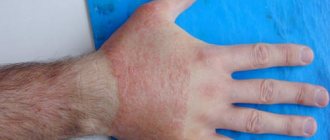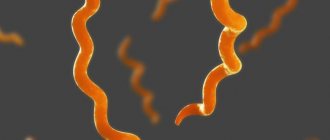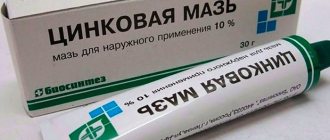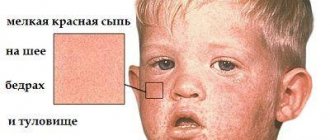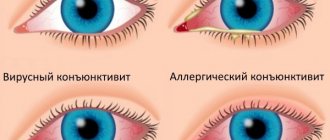Reasons for the development of dermatitis in a child
The development of dermatitis in a child indicates his congenital or acquired predisposition to allergies. Most often, the disease occurs in infants and children under 4 years of age, after which cases of the disease develop less and less often.
Risk groups for developing dermatitis:
- numerous infectious diseases during pregnancy and after birth;
- the tendency of one or both parents to allergies;
- long-term use of medications during pregnancy and after the birth of a child;
- complicated pregnancy and childbirth;
- improperly organized feeding;
- constant exposure to exhaust fumes, smoke, dyes and other pollutants;
- failure to comply with hygiene rules.
Remember! Children are very susceptible to any influences on the body, especially for children in their first year of life, who are just learning to live and interact with all manifestations of the world around them.
Symptoms
Types of dermatitis have similar symptoms, which can make identifying a specific type difficult.
How it manifests itself:
- lack of appetite, moodiness, poor sleep;
- rashes, cracks, crusts form;
- there is itching, redness, swelling of the skin;
- temperature increase.
Severe disease may be accompanied by wheezing, dry cough, and swelling of the face.
Important! If a complicated case of dermatitis is detected, the child needs urgent hospitalization. Lack of timely assistance can lead to respiratory arrest, anaphylactic shock, and convulsions.
The first symptoms of the disease should be a signal for parents to visit a doctor. He will collect anamnesis and prescribe laboratory blood tests for allergens. In children over 3 years of age, the allergen is detected by skin testing.
Preventive actions
After the child recovers, in order to avoid relapse of allergic dermatitis, it is necessary to take a number of preventive measures:
- Normalization of nutrition. If the mother follows a strict diet, the baby is fully breastfed. In children under one year of age (especially up to 6 months), all introduced complementary foods are excluded. When the symptoms of dermatitis are relieved, the products are reintroduced, following all the rules. If the symptoms of the disease do not go away with pure breastfeeding, then the child is transferred to artificial feeding with the selection of a suitable hypoallergenic formula.
- Use of natural products for hygiene procedures (hypoallergenic shampoos, gels, creams).
- Daily change of bed linen and baby's clothes. They should be made only from natural lightweight fabrics.
- Daily hygiene procedures, changing diapers - at least once every 3 hours or after each bowel movement.
- Regular wet cleaning, maintaining normal levels of temperature and humidity in the room where the child is.
- Avoid contact of the baby with pets and flowering plants.
- No smoking in the same room as the child!
- It is necessary to promptly treat gastrointestinal diseases and avoid stressful situations.
The allergic form of dermatitis is a very common pathology that occurs in many infants.
In no case should you self-medicate, since without consulting a doctor you can further harm the child’s health and provoke the emergence of serious complications of dermatitis.
Atopic dermatitis
Atopic dermatitis in children belongs to a group of diseases that are inherited. The first signs of the disease appear in childhood (up to 10 years), manifestations later than this period are unlikely.
Main symptoms of the disease:
- dryness and severe skin itching, redness, swelling, spots with blurred boundaries;
- scratching causes erosion;
- when infection occurs, suppuration appears;
- usually localized on the inside of the elbows, knees, temples, neck, collarbone, buttocks, and thighs.
The disease is characterized by periods of calm and active manifestation of symptoms. A reaction can occur to any allergen: dust, pollen, household chemicals, etc.
Atopic dermatitis in infants
In infants, the disease manifests itself as redness, dryness and flaking of the skin (mainly in the area of the cheeks and buttocks). Lack of treatment leads to an increase in the affected area, the appearance of ulcers, itching, and provokes the proliferation of bacteria and fungi.
Treatment of atopic dermatitis:
- Clothes made from natural fabrics. Pay special attention to washing powders and other household chemicals; they often contain allergens.
- Antihistamines: Suprastin, Tavegil, Claritin.
- Ointments and creams to moisturize the skin and relieve inflammation.
- Compliance with personal hygiene rules.
- When breastfeeding, a special diet for the mother. The kids' menu includes porridge and vegetable purees.
Interesting to know! There is a treatment method based on introducing doses of the allergen into the body in order to increase its resistance over time. Starting with small doses, the body is allowed to get used to the allergen.
The best way to moisturize the skin is with emollients for atopic dermatitis. Fatty products contained in cosmetics are called emollients. They facilitate easy distribution of the cream over the skin and prevent moisture from evaporating from the surface of the skin.
The most common and available emollients:
- Mustella Stelatopia;
- Emolium;
- Topicrem;
- Locobase;
- La Roche Posay Lipikar.
The main mistake parents make is to stop applying the cream to the child’s body when the disease is in a quiescent stage.
Treatment
To quickly get rid of the painful symptoms of allergic dermatitis, the main thing is to establish the cause (irritant) and eliminate its effect on the child’s body.
Therapy should be comprehensive, including all medications and non-drug treatment methods aimed at the pathogenesis and clinical manifestations of dermatitis.
Use of medications
For the traditional treatment of dermatitis in infants, experts recommend drugs from several pharmacological groups:
- Antihistamines that help reduce itching, hyperemia, and swelling of the skin. Fenistil, Suprastin, Zodak and other medications are usually prescribed in the form of ointments, gels, tablets or parenteral forms.
- Immunomodulators, vitamin and mineral complexes - to normalize immunity and restore metabolic processes in the body.
- Enterosorbents (Smecta, Laktofiltrum, Polysorb) are prescribed to bind and remove allergens, toxins and toxic metabolic products from the body.
- Enzymes are used to restore digestive processes and better assimilate beneficial nutrients.
- Pre- and probiotics - to normalize the composition of the microflora of the gastrointestinal tract, which helps increase immunity and improve digestion.
- Ointments that accelerate the regeneration of epidermal tissue (Depanthenol, Radevit, Sudocrem).
- Glucocorticoids in the form of ointments (Advantan, Elokom, Fucicort). They are prescribed to infants only according to strict indications.
- Antiseptics, antibiotics, antifungal drugs for topical use - for the prevention and treatment of secondary infection or complications.
Folk remedies
To treat dermatitis in a child, many parents resort to unconventional methods. But doctors do not recommend their use in children under one year of age, since most folk remedies of plant origin are themselves allergens. Before using any non-traditional method of therapy, you must consult with your doctor and conduct allergy tests .
The safest and most frequently used traditional medicines are:
- Birch tar. Twice a day, apply a thin layer of the substance to the affected skin.
- Decoctions, infusions of medicinal plants (chamomile flowers, calendula, succession herbs, oak root). Pour three tablespoons into a liter of boiling water, strain after cooling. The liquid is added to the water when bathing.
- Ointment made from linseed oil and chamomile. Carefully crushed flowers are mixed with oil at the rate of a tablespoon of plant material per 100 ml of oil. The ointment is used to treat rashes in the morning and evening.
- Applications with aloe or fresh pumpkin juice. A gauze swab is moistened in liquid and applied to the affected areas.
Special procedures
Physiotherapeutic methods are often included in a comprehensive treatment plan:
- laser treatment;
- quartz therapy;
- magnetic therapy;
- ultraviolet irradiation.
Seborrheic dermatitis
Seborrheic dermatitis usually affects the scalp of a child and can appear in the sternum, legs, groin, axillary folds of skin, eyebrows and eyelids. The causative agent of the disease is a fungus, and the main manifestation of the disease is yellow crusts on the skin (gneisses). The disease can occur due to nervous stress, poor nutrition, and hormonal imbalance.
Treatment:
- daily water procedures;
- use of medicated shampoos: Nizoral, Quelual DS;
- medicinal creams: Bioderma, Saforel, Friederm.
The duration of treatment and medications are prescribed by the attending physician.
Important! There is no need to panic; seborrheic dermatitis in infants usually appears at 2-3 weeks of life and disappears by the end of the second month.
Diaper dermatitis
Rashes occur due to non-compliance with the rules of hygiene and care for delicate baby skin. Prolonged contact with urine and feces and untimely diaper changes lead to inflammation. Less common is diaper dermatitis, caused by a reaction to a certain brand of diapers, soap, shampoo, or baby laundry detergent due to the allergens they contain.
How it manifests itself:
- rash on the buttocks, genitals, inner thighs;
- skin redness;
- painful sensations, itching, causing crying, refusal to eat, irritability.
Treatment of diaper dermatitis in children is as follows:
- Strict adherence to hygiene measures.
- Choose a diaper that suits your child and change it every 4-6 hours. If a child poops, change it immediately, do not keep it in a dirty diaper.
- Use hypoallergenic shampoos and soaps.
- Arrange air baths more often.
- To use powder, apply it to dry and clean skin.
- Bepanten and D-Panthenol creams are excellent for the treatment and prevention of diaper dermatitis.
Lack of timely treatment can lead to the formation of pustules with an unpleasant odor and erosions.
Symptoms
The disease manifests itself not only by the appearance of rashes on the skin, but also by damage to the digestive, respiratory and other systems.
The main signs of allergic dermatitis in an infant:
- Hyperemia of the skin. The most common localization of the lesion is folds on the legs, arms, elbows, knees, face, neck, back, intergluteal fold.
- The appearance of rashes on the inflamed areas that look like pimples or blisters.
- Dryness, flaking of the skin, formation of crusts on the child’s head, as can be seen in the photo below.
- Itching of the affected skin.
- In severe cases, swelling of the mucous membranes of the eyes, mouth, nasal cavity, and upper respiratory tract develops. Clinically, these processes are manifested by allergic rhinitis, conjunctivitis or bronchial asthma. The most dangerous manifestation is angioedema, which requires immediate hospitalization of the child.
- Deterioration in the functioning of the digestive organs: regurgitation, diarrhea, constipation, change in stool color.
- The child’s well-being is impaired - moodiness, loss of appetite, sleep.
With continuous interaction with the allergen, lack of timely treatment and good care, areas of weeping and skin irritation appear. Purulent complications often develop due to the addition of a secondary infection.
Allergic dermatitis
Allergic dermatitis occurs due to imperfect liver function in children; it cannot cope with its job (detoxification of substances), the immune system is weakened, and the body reacts with the allergen.
If an allergen enters a child's body:
- with food, with mother's milk;
- skin contact;
- through the respiratory tract.
Treatment should begin by eliminating the allergen from the diet or direct contact with the baby’s skin. Following a diet that excludes all potentially allergenic foods: chocolate, nuts, seafood, citrus fruits, etc. The doctor may prescribe antihistamines, enterosorbents to accelerate the removal of substances from the body, ointments to moisturize and relieve inflammation of the skin.
Remember! Often children simply “outgrow” this allergy as they get older. As you grow, your body's resistance increases.
Causes
The causes of dermatitis are associated with exposure to an irritating substance on the child's skin. The cause may be a substance that gets on the skin from the environment, then contact dermatitis is called. If a substance first enters the gastrointestinal tract, then into the blood and manifests itself as a reaction on the skin, the disease is called toxicoderma.
Contact
The cause of contact dermatitis in a child can be:
- Wet diapers - a rash on the body appears in places of constant contact with the skin, on the back, buttocks, stomach, groin;
- Staying in a full diaper causes a rash and redness in the groin, butt and abdomen;
- Synthetic clothing and bedding can cause a reaction on the neck, head, and around the mouth;
- Unsuitable children's cosmetics cause rashes in those parts of the body where the cream was used: in the groin, on the buttocks, on the cheeks;
- Household chemicals are also an irritant; when they come into contact with a baby’s diapers and clothes, they cause rashes on the body.
The rashes on the body become extensive and cause great discomfort. In places where rashes are most common (on the hands and elbows, cheeks and around the mouth), the skin loses elasticity, pigmentation, and becomes thin and vulnerable. If the allergen periodically affects the child, the atypical reaction intensifies.
Treatment for contact dermatitis involves limiting any contact with the irritant.
With proper care, the allergic mood of the body decreases in 80% of children. Signs of dermatitis weaken first on exposed parts of the body (on the face, around the neck, on the back and abdomen, on the legs), and then in closed areas (in the groin, on the arms, and buttocks).
Toxicoderma
Causes of toxicoderma:
- Food allergens are the most common cause of facial dermatitis in infants;
- Inhalation of exhaust gases (when traveling along roads);
- Medicines (vitamins and antibiotics often cause allergic reactions);
- Infectious diseases (form so-called infectious dermatitis in young children).
The disease is also called diathesis. The age of the child most susceptible to rashes is up to 3 years. At this age, signs of the disease (rash and redness on the face, around the mouth, in the groin) appear much more often.
Weeping dermatitis
Weeping dermatitis is skin inflammation characterized by the appearance of cracks with the separation of pus or ichor.
Causes of the disease:
- food allergies;
- reaction to medications;
- gastrointestinal diseases;
- reaction to external stimuli: cosmetics, household chemicals, etc.;
- nervous system disorders.
In children, the face and flexion/extension areas of the joints are usually affected.
Attention! To treat a disease, it is necessary to conduct a thorough diagnosis in order to determine the cause of its occurrence. The doctor prescribes treatment based on the tests and examinations performed.
Diagnostics
Prescribing effective treatment requires timely diagnosis of the disease, clarifying its form and identifying the etiological factor. To quickly make a correct diagnosis, you should consult a dermatologist or allergist.
It is usually enough for a doctor to conduct a survey of parents to collect a complete history of the disease and the child’s life, detailing the existing risk factors for the development of allergic dermatitis. To confirm the diagnosis and differentiate it from other pathologies, additional research methods may be required:
- general, biochemical blood test;
- stool examination for dysbacteriosis, scatological examination;
- Ultrasound of the abdominal organs, kidneys, pelvis;
- conducting allergy tests;
- study of immune status.
Solar dermatitis
Skin irritation occurs when exposed to direct sunlight. With this type of disease, even short-term exposure to the sun causes redness, itching, swelling, and rash.
The cause of its occurrence is not the sun's rays themselves, but substances contained in the child's skin that react with ultraviolet radiation (histamine, acetylcholine). Most often, such a reaction is caused by liver or intestinal diseases, endocrine disorders, vitamin deficiency, perfumes, cosmetics, creams, plant pollen that gets on the skin, and taking medications.
Treatment consists of taking antihistamines. To relieve itching, use zinc ointment or non-hormonal drugs: Elidel, Fenistil-gel. Baths with herbs (chamomile, chamomile, sage) perfectly relieve itching and irritation.
To prevent the occurrence of solar dermatitis, you must try to avoid exposure to the sun at the most aggressive time (from 11 to 17 hours), apply sunscreen to the child’s body, and the diet should not include fatty, salty, fried, or allergenic foods.
Perioral dermatitis
An inflammatory condition of the skin around the mouth is called perioral dermatitis. Small pimples (papules, vesicles, pustules) form around the mouth. It can occur due to climate change, weakened immune defense, disruption of the gastrointestinal tract, stress, hormonal imbalance, and cosmetics.
The principle of zero therapy is used for treatment. It consists of abolishing all used ointments, creams, cosmetics, especially glucocorticoid drugs, and reducing contact with water. Antihistamines are prescribed: Suprastin, Tavegil. Elidel cream, Metronidazole, Erythromycin, tetracycline ointment.
Remember! It is necessary to avoid sun exposure and stop using cosmetics.
Dermatitis of any type is an unpleasant and sometimes very dangerous disease if not properly treated. At the first signs of illness, you should immediately consult a doctor.



